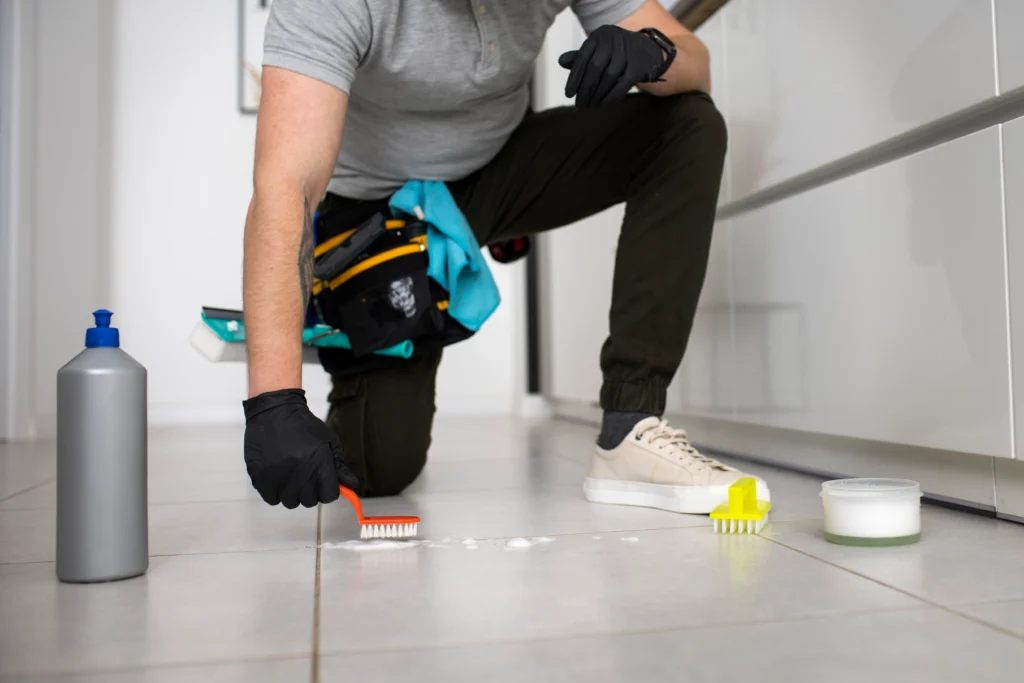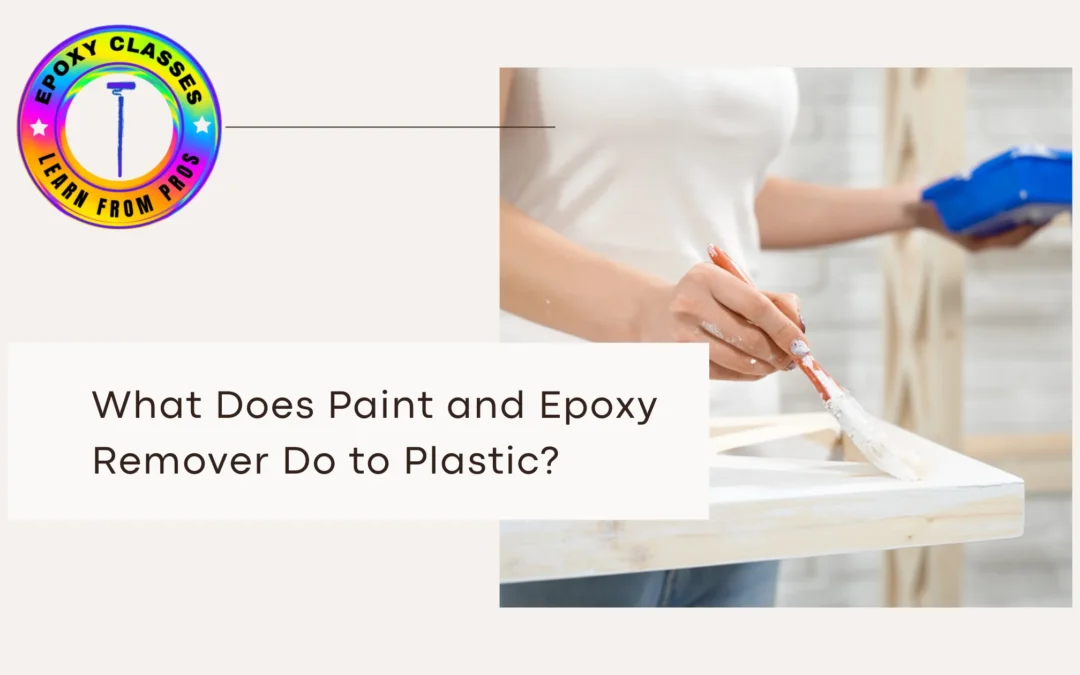What Does Paint and Epoxy Remover Do to Plastic? A Deep Dive
Welcome epoxy professionals and DIY enthusiasts, buckle up and let’s dive deep into the wild ride of paint and epoxy removers and learn what effects they have on plastic. You must be wondering what paint and epoxy removers are made up of and what happens when these chemicals meet your favourite plastic surfaces, don’t worry we have got you all covered. Get yourself ready for a thrilling ride.
At Epoxy Classes NY, we’re dedicated to giving you the information to master your skill, whether it’s clearing away an old project or building a beautiful epoxy work of art. So, let’s solve the mystery together, investigate the science, and give you secrets to help you cross this difficult path!
The Powerhouse: What Are Paint and Epoxy Removers?

Before talking about what paint and epoxy remover do to plastics, it is important to first know what paint and epoxy removers are and its chemical composition. These chemical mixtures are used to dissolve stubborn, hard layers of paint, varnish, and epoxy coatings. They are commonly made up of methylene chloride, acetone, or other harsh solvent. These removers are the go to choice for anyone who wants to strip a surface down to the bare surface, it can be for a new coat or a stunning epoxy pour. But wait, here’s the tricky part: the raw part of paint and epoxy removers does not always get along with plastic. Let’s explore why!
The Clash: How Do They Affect Plastic?
Plastic is not a single material, it comes in a variety of ranges, from polycarbonates to elastic PVC and fragile acrylics. Each type can have a different reaction. Add paint and epoxy removers into the mix, and the outcome can be a rollercoaster:
- Melting: Certain plastics like polystyrene or some thin acrylics, can actually melt if met with any paint or epoxy removers because of the harsh solvents. The chemicals target the molecular bonds, reducing the solid plastic to a sticky distorted mess.
- Cracking: Polycarbonate and other hard plastics may not dissolve or melt into a sticky texture but can become stress-cracked or crazed resulting in a spiderweb-like break that ruins its smooth shinny surface and also destroys its clarity and strength.
- Discoloration: Some plastics are strong enough to hold things together but due to some harsh solvent certain removers can drain away the dyes or cause plastics to become cloudy, stained, or faded.
- Softening: Flexible plastics such as polyethylene may soften and lose their shape or purpose. These plastics when met with paint and epoxy removers get weak and no longer serve its function.
The effect varies depending on the type of plastic, the chemical composition of the remover, and for how long the plastic was exposed to the remover. Yes, the duration matters too. A quick wipe will not cause too much damage but if you let it sit and soak, that will be a huge problem. It’s like waiting for a disaster to happen!
Why Does This Happen? The Science Behind it
It’s time to get a little nerdy here and learn the science behind this dramatic meetup. When paint and epoxy remover meets plastic, it destroys and breaks up the chemical bonding of the surface by penetrating in the coating, peeling the surface off. Plastics tend to be polymers, meaning they have long molecules and many chemicals used in removers like acetone or toluene are ready to tangle and get wrapped up in the long chains.
What actually happens is that they slip in and destroy the structure. Here your plastic integrity is compromised. It’s important to keep this in mind that not all plastics behave the same. High density polyethylene (HDPE) resists some of the milder removers, however delicate plastics like acrylonitrile butadiene styrene (ABS) might fold under pressure quickly. Basically think of it as a chemical showdown, where plastic isn’t always the winner!
Real-World Risks: When Plastic Meets Remover
Let’s discuss a real life example to explain the risk more clearly. Imagine you’re in one of our epoxy workshops, working on a beautiful resin table. By mistake you spill some epoxy and reach out for a remover to wipe it off, but oh no, your plastic mixing cup melts. Or maybe you’re cleaning paint from a mixed-material piece, and the plastic trim turns cloudy. Remember, these examples are not just hypothetical scenarios; these accidents do happen in real settings and they are real risks.
At home or in the workshop, using paint and epoxy removers near plastic tools, containers, or surfaces can lead to costly damage, ruined projects, or even safety hazards if a weakened plastic part fails.
How to Protect Your Plastic
Yes, paint and epoxy removers are risky to use around plastics but wait, don’t you worry epoxy enthusiasts we have got you all covered. With some knowledge and skills you can continue to use paint and epoxy removers without making your plastic a victim. Here’s how you can protect your plastic:
- Know Your Plastic: Identifying the type is crucial. Know the recycling codes for example “PP” for polypropylene and “PS” for polystyrene or you can also test a small, inconspicuous area. Don’t know? Our services at Epoxy Classes NY include expert advice. Join up and learn the ways like a professional.
- Choose the Right Remover: While choosing removers, avoid the strong ones and go for milder, plastic-friendly formulations like citrus- or water-based removers. Read labels carefully and avoid the harsh ones like methylene chloride on delicate plastics.
- Time It Right: Act quickly, dab or wipe it immediately, don’t let it sit for too long. A small application may remove epoxy or paint without destroying the plastic beneath.
- Shield and Protect: When working with epoxy make sure to wrap and cover all the plastic parts in the surrounding or remove them altogether before using removers.
- Clean Up Smart: Once you’ve used a remover, wash with water or mild soap to remove any remains before it invades any space that has plastics.
The Takeaway
Paint and epoxy removers work best when you have to get rid of the old coating and make way for the new one, but they can be critical and risky to use if plastic is involved. They melt, crack, discolor, or get soft, ruining your project completely. Equipped with knowledge, proper materials, and a dash of caution, you can store your plastics and your epoxy skills strong. Check out additional tips and tricks on our blog site, and feel free to reach out with questions.
Frequently Asked Questions
Q1. Why do some plastics melt when exposed to removers?
Removers contain chemicals like acetone or methylene chloride that act on the molecular bonds in some plastics, breaking them down. They damage the plastic structure, making them a gooey, sticky mess.
Q2. Are there plastic-safe paint and epoxy removers?
Yes, there are milder options, like citrus-based or water-based removers. These removers are gentler on some plastics. Make sure to read the label first and look for “plastic-safe” claims, but still test it out on a small area. Harsh chemicals like methylene chloride are riskier, so proceed with caution.
Q3. How can I protect plastic when using a remover?
When using removers make sure to provide a shield to your plastic. Protect it by covering the plastic parts with tape. Remove it completely from that space, or apply the remover quickly and clean it immediately, do not let it sit or soak. After use, wash it with water or mild soap to clean up any residue.
Q4. What happens if I leave the remover on plastic for too long?
Leaving the remover on plastic for too long can be harmful. It can melt, crack or discolor plastic, ruining your project completely. Timing is key in epoxy work, act quick and wipe it off immediately
Q5. Will paint and epoxy remover ruin my plastic tools or containers?
Yes, it might ruin it. Tools like plastic mixing cups, spatulas, or containers can soften, melt or get weak if exposed to harsh removers. Use metal or glass tools when possible, or go for mild removers that are safe to use on plastics.
Q6. How do I know which type of plastic I’m working with?
Look for recycling codes like “PP” for polypropylene or “PS” for polystyrene that are mentioned on the item, or check the manufacturer’s specifications. If you are still not sure, test a small area first.
